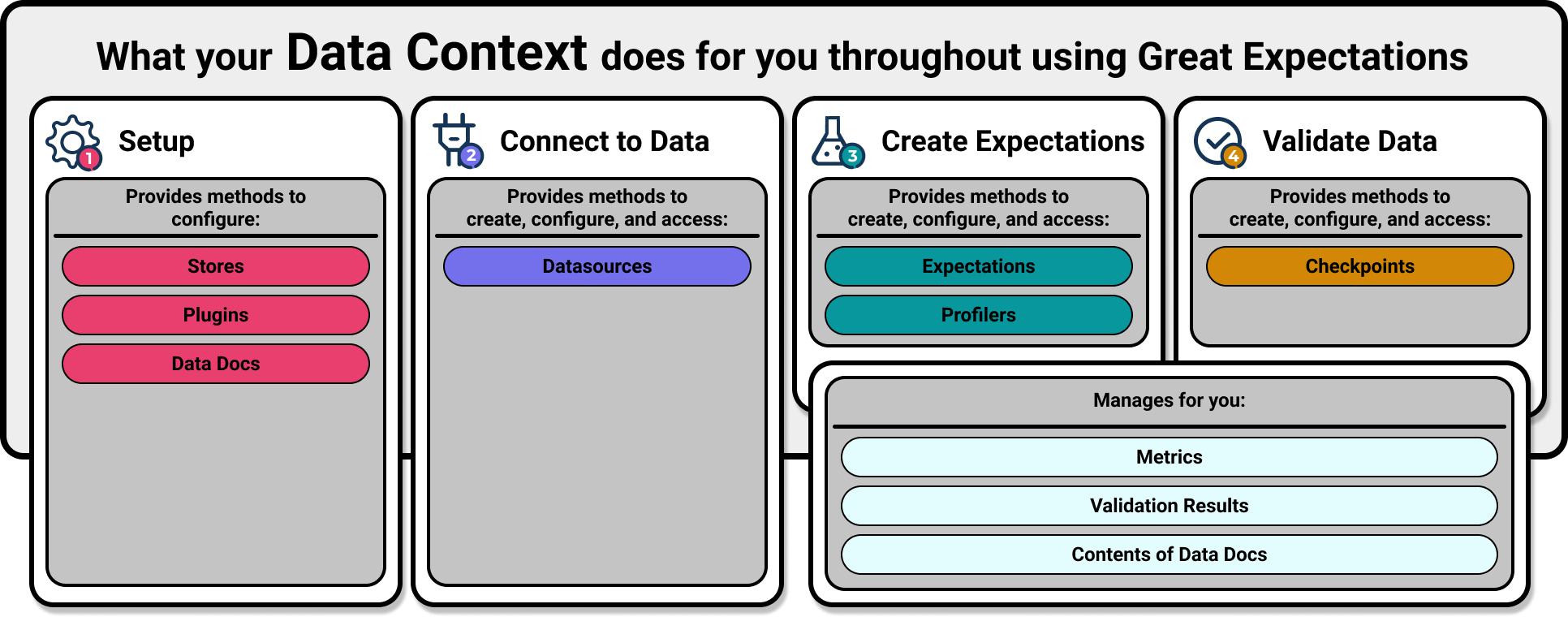 Setup: Overview
Setup: Overview
|
|
|
|
|
|
|
|
- Completing Step 1: Setup of the Getting Started tutorial is recommended.
Getting started with Great Expectations is quick and easy. Once you have completed setup for your production deployment, you will have access to all of the features of Great Expectations from a single entry point: Your Data ContextThe primary entry point for a Great Expectations deployment, with configurations and methods for all supporting components.. You will also have your StoresA connector to store and retrieve information about metadata in Great Expectations. and Data DocsHuman readable documentation generated from Great Expectations metadata detailing Expectations, Validation Results, etc. configured in the manner most suitable for your project's purposes.
The alternative to manual Setup
If you're not interested in managing your own configuration or infrastructure then Great Expectations Cloud may be of interest to you. You can learn more about Great Expectations Cloud — our fully managed SaaS offering — by signing up for our weekly cloud workshop! You’ll get to see our newest features and apply for our private Alpha program!
The Setup process
Setup entails ensuring your system is prepared to run Great Expectations, installing Great Expectations itself, and initializing your deployment. Optionally, you can also tweak the configuration of some components, such as Stores and Data Docs. We'll look at each of these things in sequence.
Note: configuration of DatasourcesProvides a standard API for accessing and interacting with data from a wide variety of source systems., Expectation SuitesA collection of verifiable assertions about data., and CheckpointsThe primary means for validating data in a production deployment of Great Expectations. will be handled separately. We consider those to be configuration of components after your main Great Expectations deployment is set up.
1. System Dependencies
The first thing to take care of is making sure your work environment has the utilities you need to install and run Great Expectations. These include a working Python install (version 3.6 or greater), the ability to pip install Python packages, an internet connection, and a browser so that you can use Jupyter notebooks. Best practices are to use a virtual environment for your project's workspace.
If you are having trouble with any of these, our documentation on Supporting ResourcesA resource external to the Great Expectations code base which Great Expectations utilizes. will direct you to more information and helpful tutorials.
2. Installation
Installing Great Expectations is a simple pip command. From the terminal, execute:
pip install great_expectations
Running this command in an environment configured to accept Python pip install commands will handle the entire installation process for Great Expectations and its dependencies.
See our guides for the installation process for more information.
3. Initialize a Data Context
Your Data Context contains the entirety of your Great Expectations project and provides the entry point for all of the primary methods you will use to configure and interact with Great Expectations. At every step in your use of Great Expectations, the Data Context provides easy access to the key elements you will need to interact with. Furthermore, the Data Context will internally manage various classes so that you don't have to. Because of this, once you have completed the configurations in your Setup there will be relatively few objects you will need to manage to get Great Expectations working for you.
That's why the first thing you'll do once you've installed Great Expectations will be to initialize your Data Context.

Initializing your Data Context is another one-line command. Simply go to the root folder for your project and execute:
great_expectations init
Running this command will initialize your Data Context in the directory that the command is run from. It will create the folder structure a Data Context requires to organize your project.
See our guides for configuring your Data Context for more information.
4. Optional Configurations
Once your Data Context is initialized, you'll be all set to start using Great Expectations. However, there are a few things that are configured by default to operate locally which you may want to configure to be hosted elsewhere. We include these optional configurations in our Setup instructions. Using the Data Context, you can easily create and test your configurations.
Stores
Stores are the locations where your Data Context stores information about your ExpectationsA verifiable assertion about data., your Validation ResultsGenerated when data is Validated against an Expectation or Expectation Suite., and your MetricsA computed attribute of data such as the mean of a column.. By default, these are stored locally. But you can reconfigure them to work with a variety of backends.
See our guides for configuring Stores for more information.
Data Docs
Data Docs provide human readable renderings of your Expectation Suites and Validation Results. As with Stores, these are built locally by default. However, you can configure them to be hosted and shared in a variety of different ways.
See our guides on configuring Data Docs for more information.
Plugins
Python files are treated as
PluginsExtends Great Expectations' components
and/or functionality.
if they are in the plugins directory in
your project (which is created automatically when you
initialize your Data Context) can be used to extend
Great Expectations. If you have
Custom ExpectationsAn extension of the `Expectation` class,
developed outside of the Great Expectations
library.
or other extensions to Great Expectations that you
wish to use as Plugins in your deployment of Great
Expectations, you should include them in the
plugins directory.
Wrapping up
That's all there is to the Setup step. Once you have your Data Context initialized you will almost always start from your Data Context (as illustrated below) for everything else you do through Great Expectations.
import great_expectations as ge
context = ge.get_context()
From here you will move on to the next step of working with Great Expectations: Connecting to Data.